By Lenah Bosibori
Nairobi, Kenya: Transitioning to a circular economy presents new opportunities across the world, this is because people are looking at the recovery of resources such as waste products from households which were in the past being thrown away and can now be turned around to be resources and raw materials for recycling.
Speaking during the 8th edition of the Annual Circular Economy Conference in Nairobi, Dr Ayub Macharia, Director Compliance National Environment Management Authority (NEMA) said that Kenya as a country has expanded the circular economy value chain and has tasked the Producer Responsibility organizations to look into the plight of the waste pickers.
“We have tasked the Producer Responsibility organizations to look at the plight of the waste pickers so that they have decent jobs, they need to know how much are the waste pickers going to be paid for their collections for every product,” said Macharia
He added that they have expanded the circular economy value chain and provided an opportunity to employ more people in the chain.
Macharia adds, “We expect that they should be dressed properly and be provided with protective equipment because the law says that all the waste pickers should be registered by the County so that they are known and can be budgeted for, it is not like before where we had a lot of informality, now they are formally known,” he added.
According to the International Labour Organization, a circular economy could benefit the environment while boosting competitiveness and resilience. Between 7-8 million jobs net growth in jobs globally due to a circular economy by 2030.
The European Commission predicts a 2.7 percent increase in employment in Africa from the transition to a circular economy.
“Circular economic activities will increase the demand for labour in some sectors like product repair, material reprocessing, and recycling generating new employment opportunities in some countries,” said Luke Carroll, junior Technical Officer, Extractives, Energy and Manufacturing Unit ILO.

He also adds that 9 percent of our world is circular. “Instead of today’s take-make-dispose linear model of production and consumption, the circular economy is restorative,” he added.
Linda Kosgei Head of Multilateral Environment Agreements (MEAs) in the Ministry of Environment, Climate Change and Forestry noted that for many years, Kenya has been utilizing the linear model of waste management where people generate waste, and once finished with it the final product is at the dump site.
“Now the government has put in place new mechanisms, new policies, and new legislations to do with sustainable waste management,” she added.
In 2021, through the Sustainable Waste Management Policy and the Sustainable Waste Management Act, the country’s policy has shifted from the linear model to the circular model according to Kosgei
Kosgei said that the youth have a big potential in the circular economy value chain if only they organize themselves under various umbrellas like Kenya Private Sector Alliance (KEPSA) so that they can be able to access finance for recycling.
“Let the youth organizations organize themselves under the various umbrella bodies and under the private sector because there is strength in numbers, to approach various financiers, and also come up with innovative models and innovative ideas in which they will be of interest to the various financials to come on board and support them,” said Kosgei.
The Ministry of Environment in Kenya is revising legislation to align with extended producer responsibility regulations for plastic and other waste. It is also working to harmonize regulations with other stakeholders to ensure no conflict or duplication, and the regulations will come into force soon.
According to Charles Akol Environmental affairs officer, Green and Blue Economy Section, Technology, Climate Change and Natural Resources Management Division ECA, E-Waste has increased, 2019 7.3 kilograms of e-waste per capita was generated globally
Estimates are that every year close to 13 million tons of plastic leak into the oceans where it harms biodiversity economies and potentially human health
“For Africa, the population is forecast to double its 2017 levels by 2050, this means increased pressure on the continent’s already stretched resources, need to ensure efficient and sustainable use of our resources to grow our economies to create jobs and lift around 460 million people out of poverty,” said Akol.














